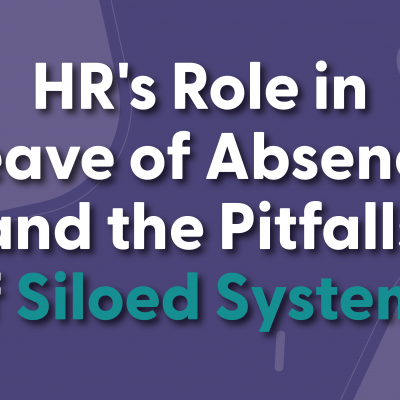Silos may be great for storing grain and/or missiles, but silos are less than spectacular when they’re prevalent in your leave of absence management processes. As an HR professional, you’re asked to do a lot…like…a lot a lot, and far too often your most critical tasks are also the most time-consuming ones because you’re stuck with manual processes and systems that aren’t talking to each other, and in some cases are speaking different languages altogether.
HR’s role in managing leaves of absence is as complex as it is cumbersome. You have to keep track of your employees’ journeys, support and communicate with them along the way, document everything, keep your organization compliant, handle communicating with carriers, ensure payroll is accurate, educate with empathy, and do all of this consistently. For every leave.
The complexity amplifies of course as leave laws expand and evolve, and as workforces disperse across the country where different regulations and requirements may apply. And all of those complexities amplify as your organization grows and leave requests rise.
Why Leave Management System Silos Aren’t Sustainable
When your HR software or information systems are isolated and disconnected it hinders their ability for effective communication and data sharing. When your various HR functions rely on systems that are managed using separate and non-integrated software or databases, you’re setting yourself up for operational inefficiencies, risk exposure, and inconsistencies.
As it pertains to leave of absence management, siloed systems become an even bigger issue as your potential points of failure get magnified. The lack of integration between your HRIS, leave tracker, payroll, and sensitive file storage can lead to various challenges when trying to administer leaves of absence at scale.
What are these challenges we speak of you ask? So thoughtful of you to ask…
Data Inconsistency: Despite your best efforts, information about your employee population may be inconsistent across different systems, leading to errors and discrepancies. These pesky and potentially costly inconsistencies can arise for a multitude of reasons, whether it be from manual errors (we’re only human), outdated entries (so hard to keep current), or the lack of synchronization between systems (silo city).
Inconsistent data can lead to confusion for employees and your HR team alike. It can hinder accurate decision-making, compromise the reliability of analytical insights, and potentially create a whole world of trouble should discrepancies arise or an audit take place.
On the long list of “ways you’d prefer to not spend your time,” resolving data inconsistency has to be near the top as it often requires time-consuming, manual effort, to identify and rectify each discrepancy.
Consolidating your LOA systems into one leave management platform that integrates with your HRIS and provides holistic leave guidance to your employees and your real-time info to your payroll team can help ensure your data is accurate and consistent throughout the leave of absence journey.
Workflow Inefficiency: When you’re required to dedicate a significant amount of your precious time to manually inputting and reconciling data across diverse systems, it’s likely at the severe detriment to workflow efficiency.
Most HR and People Ops teams can’t afford to deplete your valuable resources that otherwise could be allocated to strategic HR endeavors. The repetitive nature of manual data management across systems diminishes the overall productivity of your team and hinders the nimbleness of your operations.
To enhance your team’s leave of absence management efficiency, you guessed it, you should consider adopting an integrated solution that automates the process and stores all pertinent data and information in one place. This approach minimizes laborious manual tasks and empowers your team to focus on more impactful activities and strategic initiatives.
Limited Visibility: When it comes to both driving cars and leaves of absence, blindspots can be devastating and derail everything. If you’re tracking FMLA hours in a spreadsheet, leave dates on your calendar, STD paperwork through your insurance carrier, and payroll in your HRIS, you’re likely finding that you lack a comprehensive view of leave-related data, making it difficult to identify potential issues or make informed strategic decisions.
The lack of integration between leave-related systems prevents you from obtaining a holistic view into your organization’s leaves of absence at any given time and impedes your ability to provide accurate support for an employee on leave because you’re never sure if all of your siloed systems are operating from the same source of truth.
This restricted visibility can potentially hinder your workforce optimization and hampers your team’s ability to align your HR initiatives with broader organizational goals. An integrated leave management system should deliver a unified platform for data for all things leave. A single source of truth that makes facilitating a leave of absence as seamless as the flow of information is accurate.
Complete visibility into every aspect of your organization’s leaves will provide you and your team the insights needed for empathetic leave support, workforce management, and impacting overall business outcomes.
Poor Communication: Siloed systems and poor communication. Name a more iconic duo. When your leave of absence management systems are siloed it creates barriers between different, yet critically important, elements of your leave process. Communication confusion between systems, whether it be the State of California and your payroll team, or the employee and your STD carrier, can have dramatic and negative consequences.
If a communication breakdown occurs in the leave process it can mean the difference between an employee having job protection, a manager not knowing he can’t legally say what he or she just said, and creating a confusing experience for an employee who is simply trying to navigate life.
Transparent communication can only be achieved by centralizing your leave of absence management systems, which fosters connectivity between your HR team, the employee on leave, their manager, and payroll. All of this will also enhance the overall efficiency of your process, ensuring a more synchronized and effective approach to managing leaves within your organization.
Increased Costs: Mo’ systems mo’ (budget) problems. Managing disparate systems in order to facilitate one leave of absence requires individualized upkeep, upgrades (which aren’t always cheap), and potential compatibility issues that may find your department incurring higher operational and IT costs.
That’s to say nothing of the potential costs associated with missing out on your employees applying for state benefits, failing to deliver for clients due to poor visibility into workforce planning, or fighting off lawsuits because an employee’s manager has been pressuring them to return and wasn’t in the know that the employees leave was extended and wasn’t educated on what a manager can and can’t say to an employee on leave.
Consolidating leave of absence management functions into a single integrated platform not only lowers operational costs but also enhances your team’s capability to support employees on leave at scale.
Is a Dedicated Leave of Absence Management Solution Right for You?
No two People Ops teams are created equal. They all have their particular quirks and characteristics that keep them successful and impactful within their unique organizational circumstances.
But if you’re finding that time and again the LOA process has you feeling DOA, it’s likely because you’re trying to juggle a half-dozen platforms and coordinating with a handful of stakeholders. With manual processes, it becomes increasingly difficult to have everyone on the same page or work with data with much confidence in its accuracy.
A dedicated leave of absence management solution can consolidate, automate, and educate while providing a real-time, single source of truth for all your leave data. You can save time, money, and regain the confidence that your employees are being supported when they need it most.
About Tilt
Tilt is leading the charge in all things leave of absence management through easy-to-use tech and human touch. Since 2017, our proprietary platform and Empathy Warriors have been helping customers make leave not suck by eliminating administrative burdens, keeping companies compliant, and providing a truly positive and supportive leave of absence experience for their people.







